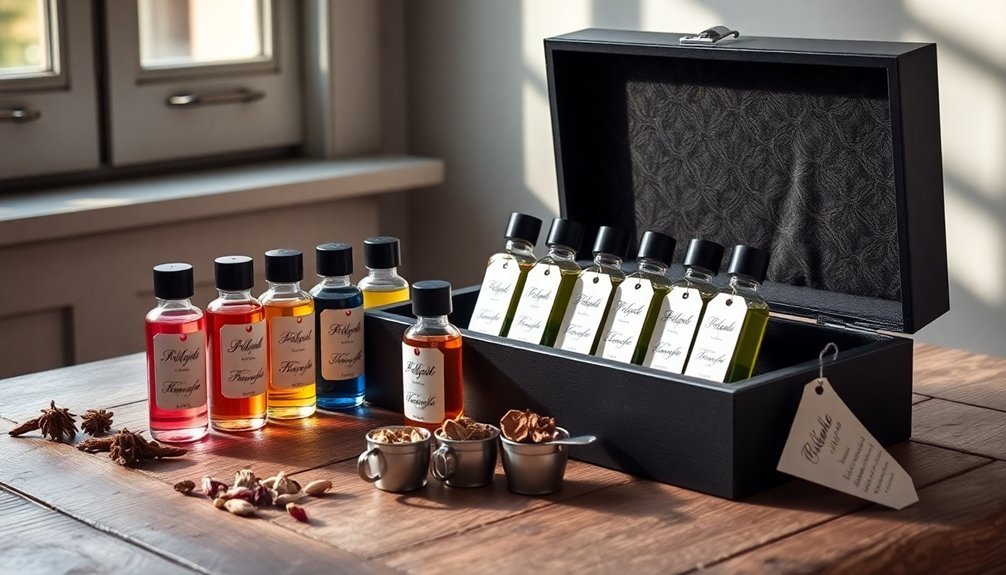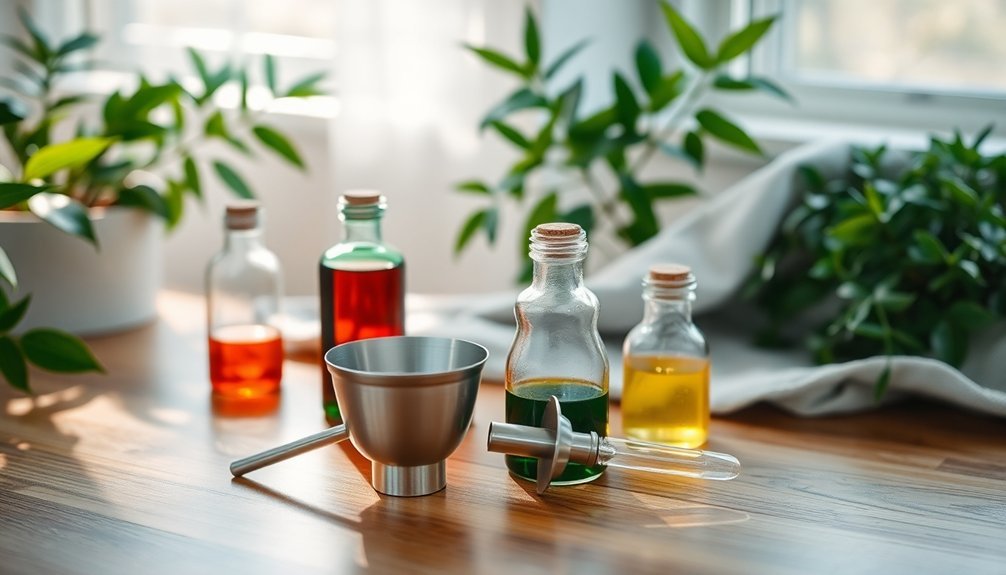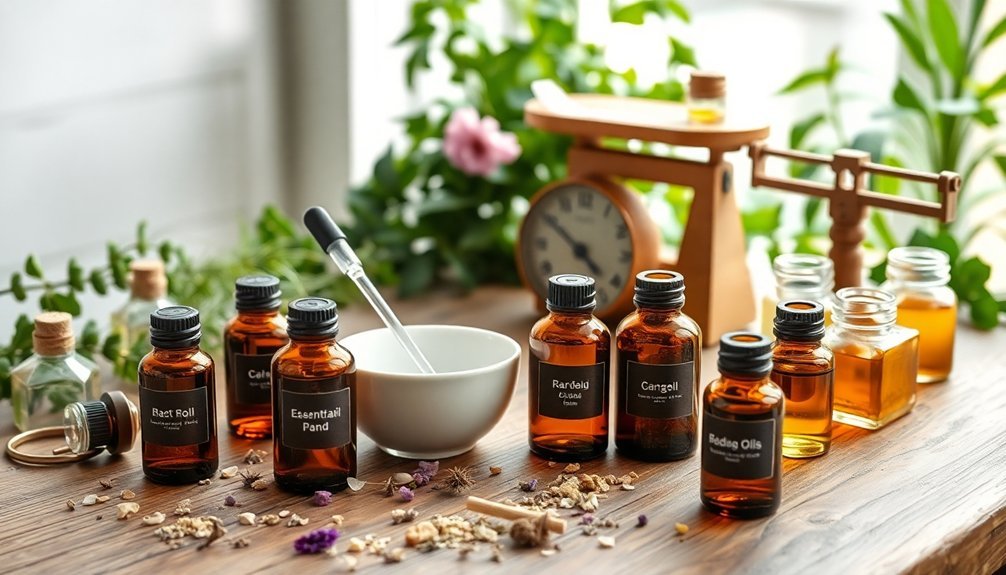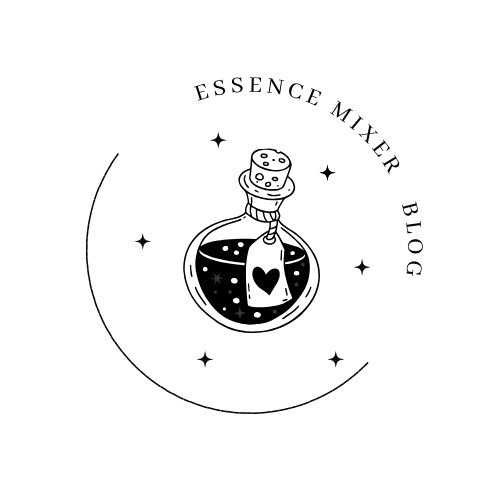Store your fragrance oils in dark glass containers at temperatures between 60-75°F (15-24°C) to protect them from UV damage and heat. You'll want to keep them in a cool, dry place away from direct sunlight and heat sources. Label each bottle with opening dates and monitor for changes in scent or appearance. Transfer oils to smaller containers as levels decrease to minimize oxidation. Proper storage techniques can release up to two years of aromatic potential.
Selecting Quality Fragrance Oils for Long-Term Storage

When it comes to storing fragrance oils successfully, selecting high-quality products from trusted suppliers is your essential first step.
You'll want to purchase from reputable sellers who comply with safety standards, as this directly impacts your oils' effectiveness and long-term storage potential.
While you might notice higher prices from quality suppliers, this often reflects their commitment to premium ingredients and safety regulations.
For ideal shelf life, which typically ranges from 1-2 years, choose oils packaged in dark glass bottles. These containers protect your fragrance oils from harmful UV light that can degrade their composition.
Remember to consistently monitor your storage conditions to maintain quality.
Dark Glass Containers and UV Protection Methods
Building on your choice of quality fragrance oils, proper storage containers play a crucial role in preserving their potency. Dark glass containers, particularly amber bottles and cobalt bottles, provide essential UV protection that shields your oils from harmful light exposure.
You'll want to transfer your fragrance oils from plastic containers to dark glass ones for long-term storage, as this prevents unwanted chemical reactions that can alter your oils' composition.
The dark glass acts as a barrier, maintaining oil integrity by blocking damaging UV rays that would otherwise degrade your fragrances. When storing your oils, verify you're using tightly sealed containers to prevent oxidation from exposure to air.
This combination of UV protection and proper sealing will notably extend the life of your fragrance oils while preserving their original scent quality.
Temperature Control and Environmental Factors

Since fragrance oils are highly sensitive to environmental conditions, maintaining proper temperature control is essential for preserving their quality.
Store your oils in a cool, dry place where ideal storage temperatures range between 60°F to 75°F (15°C to 24°C).
You'll want to protect your fragrance oils from direct sunlight and keep them away from heat sources like stoves or radiators, as these environmental factors can trigger chemical changes and increase evaporation.
While refrigeration can help extend your oils' lifespan, remember to let them reach room temperature before use to prevent condensation.
It's also vital to monitor humidity levels in your storage area, as moisture exposure can lead to mold growth and compromise your oils' integrity.
Preventing Oil Oxidation and Degradation
You'll need to take proactive steps to prevent your oils from oxidizing, which begins the moment they're exposed to air.
To minimize oxygen contact, transfer your oils to smaller dark glass bottles as the level decreases, leaving less room for air to interact with the remaining oil.
Make sure you're tightly sealing all containers after each use, as proper closure is essential for maintaining oil freshness and preventing unnecessary exposure to oxygen.
Minimize Oxygen Exposure
To maintain the quality and longevity of your oils, protecting them from oxygen exposure is essential. When storing fragrance oils, you'll need to be vigilant about minimizing contact with air to prevent degradation.
Here are four critical steps to minimize oxygen exposure:
- Transfer the oil to smaller bottles as levels decrease, reducing headspace and limiting oxidation.
- Use sterilized tools when handling oils to prevent contamination and unwanted oxygen introduction.
- Store oils in dark glass bottles to create an effective barrier against both light and oxygen infiltration.
- Always replace caps tightly after each use to seal out air.
Remember to regularly inspect oils for any signs of degradation, such as changes in scent or appearance.
Following these practices will help preserve your oils' quality and extend their shelf life considerably.
Transfer Between Glass Containers
When storing fragrance oils for extended periods, transferring them between glass containers becomes an essential step in maintaining their quality.
You'll want to move your oils from larger plastic containers to dark glass bottles to reduce oxygen exposure and extend their shelf life.
To guarantee proper transfer between glass containers, fill each bottle to the top, leaving minimal air space to protect the fragrance integrity.
Always use sterilized tools during the process to prevent contamination.
Keep your bottles' caps tightly sealed after each use to shield the oils from air, light, and heat.
Monitor your stored oils regularly for any degradation signs, such as color changes or scent alterations.
Following these safe oil storage practices will help preserve your fragrances' potency and guarantee they remain effective for future use.
Safe Handling and Transfer Techniques

Proper handling and transfer of fragrance oils requires three essential practices: using sterilized tools, maintaining a clean environment, and following precise storage protocols.
When you're ready to transfer oils, you'll need to prioritize cleanliness and precision to maintain fragrance quality.
- Keep your sterilized tools, like pipettes and droppers, readily available to prevent contamination during oil storage and transfer.
- Don't remove the original cap until you're ready to transfer, minimizing exposure to oxygen.
- Choose smaller glass containers for transfer to reduce air space and guarantee better preservation.
- Track usage by labeling each container with opening dates and contents.
Remember to avoid transferring oils in humid conditions, as moisture can compromise your fragrance quality.
Monitoring Shelf Life and Expiration Dates
How long your fragrance oils last depends largely on your monitoring practices. Start by labeling each bottle with its opening date, since most fragrance oils maintain their quality for 1-2 years under proper storage conditions.
You'll want to track usage and record purchase dates to guarantee you're using oils before they expire. Keep your oils in a cool, dark environment to prolong freshness and prevent degradation.
Regularly inspect your collection for changes in scent, color, or consistency – these are key indicators that an oil may be past its prime. To stay organized, implement an inventory management system like a spreadsheet.
This helps you monitor which oils are approaching their expiration dates, allowing you to use them while they're still at their best quality.
Best Practices for Blending and Experimentation

Set up your blending station with clean, organized equipment and a dedicated notebook to track your experimental combinations and measurements in detail.
You'll want to follow proper safety protocols while testing, including using protective gloves and working in a well-ventilated area to avoid direct contact with concentrated oils.
When you discover successful oil combinations, document the exact ratios, notes about the resulting fragrance, and any observations about how the scent develops over time.
Organizing Your Blending Station
Creating an efficient blending station starts with three essential organizational elements: categorized storage, proper tools, and a well-documented inventory system.
Your workspace's organization directly impacts the quality of your fragrance formulations and streamlines your creative process.
To maintain an effective blending station:
- Sort your fragrance oils into clearly labeled containers by scent families (floral, citrus, woodsy), making selection quick and intuitive.
- Store all oils in dark glass bottles to protect against UV damage and preserve their integrity.
- Keep detailed inventory records tracking purchase dates and shelf life to guarantee oil freshness.
- Use sterilized tools and maintain a clean workspace to prevent contamination.
When experimenting, work with small batches to minimize waste and allow for easy adjustments to your formulations before scaling up successful blends.
Equipment Safety While Testing
Your organized blending station sets the stage for safe experimentation, but proper equipment handling remains equally important. You'll need sterilized equipment and protective gear to create safe fragrance blends. Work in a well-ventilated area to prevent allergic reactions from concentrated vapors.
| Equipment | Purpose | Safety Measure |
|---|---|---|
| Glass Tools | Blending | Sterilize before use |
| Measuring Devices | Accurate Measurements | Calibrate regularly |
| Safety Goggles | Eye Protection | Wear during blending |
| Gloves | Prevent Skin Contact | Replace if damaged |
| Blending Containers | Storage | Label contents/date |
Keep your workspace organized by clearly labeling all blending containers with contents and dates. Double-check your measuring devices regularly to maintain accuracy in your experiments. Remember to clean and sterilize all glass or stainless steel tools between uses to prevent cross-contamination of your fragrance blends.
Recording Successful Oil Combinations
When experimenting with essential oil blends, maintaining detailed records guarantees you'll replicate your successes and learn from less effective combinations.
Create a systematic approach to recording your fragrance combinations by implementing proper documentation methods for your oils and scents.
Follow these essential steps for tracking your blends:
- Label each blend with creation date and scent profile description
- Document precise ratios of oils used in successful combinations
- Assign category numbers to organize blends by type or purpose
- Record any modifications made during the storage process
Keep your records organized and easily accessible, allowing you to build a personal library of proven combinations.
When you're testing new blends, start with small quantities and document every adjustment.
This methodical approach guarantees you'll develop a valuable reference system for your fragrance-making journey while minimizing waste and maximizing success.
Frequently Asked Questions
How Should Fragrance Oils Be Stored?
Store your fragrance oils in dark glass bottles and keep them in a cool, dark place. You'll want to seal caps tightly, avoid sunlight, transfer to smaller containers when needed, and track opening dates.
What Is the 30/50/20 Rule for Essential Oils?
You'll want to blend your essential oils using 30% top notes for initial scent, 50% middle notes for body, and 20% base notes for lasting power. This ratio creates a balanced, harmonious fragrance.
What Is the Best Carrier Oil for Homemade Perfume?
You'll find fractionated coconut oil is your best choice for homemade perfume since it won't alter scents, has a long shelf life, and stays liquid. Jojoba oil's also excellent as it mimics skin's natural oils.
How Do You Store Homemade Essential Oils?
You'll need to store your homemade essential oils in dark glass bottles, keep them in a cool, dark place, and seal them tightly. Don't forget to label the opening date and minimize oxygen exposure.
In Summary
You'll get the most out of your fragrance oils by following proper storage methods. Keep your oils in dark glass bottles away from sunlight, maintain stable room temperatures, and always handle them with clean tools. Don't forget to label everything with dates and ingredients. By staying vigilant about storage conditions and monitoring your oils regularly, you'll preserve their quality and enjoy your custom scents longer.





Leave a Reply